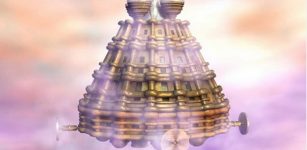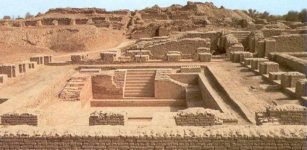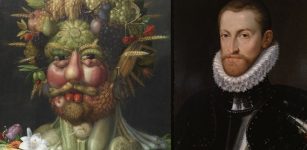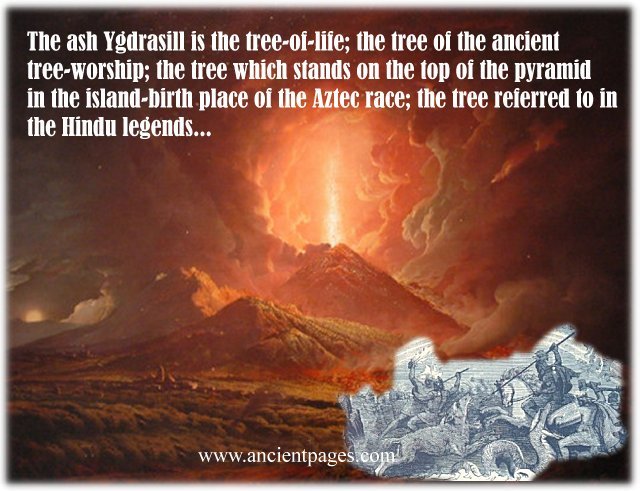Yggdrasil: Eternal And Sacred Tree Of Life In Norse Mythology
Ellen Lloyd - AncientPages.com - The tree of life is mentioned in many ancient myths and legends of the world.
In Norse mythology, it is called Yggdrasil, an eternal and sacred Ash tree with branches stretching out to harbor nine worlds. It has three roots, and each one reaches a different mysterious world. The first root is connected with Asgard, the ancient kingdom of the powerful Norse gods.
 Left: Yggdrasil symbol. Right: An 1847 depiction of the Norse Yggdrasil as described in the Icelandic Prose Edda. By Oluf Olufsen Bagge
Left: Yggdrasil symbol. Right: An 1847 depiction of the Norse Yggdrasil as described in the Icelandic Prose Edda. By Oluf Olufsen Bagge
The second root goes all the way to Jötunheimr, the home of the fearful giants, and the third root stretches to Niflheim, a place shrouded in primordial darkness, cold, mist, and ice.
In each of the worlds, there is a sacred well. In Asgard stands Urd's well, where the gods hold daily meetings. In Jötumheimr stands Mimir's well (Mímisbrunnr), associated with Mimir, the Norse god of wisdom. It is said that the great god Odin sacrificed an eye to Mimir in exchange for a drink from Mimir's well. In Niflheim, there is a well called Hvergelmir from which many rivers flow.
In Old Norse, Yggdrasil is called Mimameidr. This giant tree supports the Universe. How Yggdrasil came to existence is not entirely clear, but according to most Norse mythology researchers, the sacred Tree of Life grew out of a well called Urd.
The name comes from Yggr, meaning "The Terrible One," a name frequently given to Norse god Odin. For the well, the term "Urd" meant "destiny." Both names can be linked to the Norsemen's' concepts of time. The Well of Urd depicts a "reservoir of completed or ongoing actions that nourish the tree and influence its growth.
The flow of time in Norse mythology was not linear but cyclical. The growth of Yggdrasil depended on how the waters of the past seeped into the tree, affecting its form. Eventually, this water gathers on the leaves, like the dew, and runs back into the well, thus creating a new present. Those who gained control over this flow were said to possess great magic because they displayed "a greater degree of control over destiny.
In Norse philosophy, the power of free will and fate interact and give birth to reality.
Yggdrasil is one of many variations of the Cosmic Axis or Universal World Tree, known to all human cultures and home to many fascinating creatures. Many different creatures lived in Yggdrasil. An eagle lived at the very top of Yggdrasil, and a dragon named Nidhogg lived at the bottom of the tree. Both hated each other and were bitter enemies. The Nine Worlds are guarded by the serpent Jormungand.
When Gangleri, the earliest recorded king in Scandinavia, asks about the location of the holiest place of the gods, he is told it is the ash Yggdrasil. There the gods must hold their courts each day. Yggdrasil is mentioned in two books in the Prose Edda; Gylfaginning and Skáldskaparmál.
Fragment of the Överhogdal tapestry - Yggdrasil. Unknown author - Public Domain
In the Well of Urd live the Norns, three wise women and shapers of destiny who recorded days in a person's life. The Well of Urd (Well of Destiny) plays a central role in the image of Yggdrasil.
The Well of Urd and its waters nourish the tree, and the water cycle expresses a circular passage of time. The well, which corresponds to the past, influences the tree's growth, which corresponds to the present. However, unlike our modern, linear conception of time, the present returns to the past, even retroactively changing it!
With the world's rebirth after Ragnarök, the golden age of the Norse gods will return. After Ragnarök, the Doom of the Gods, and the apocalyptic record of the coming comet, the world tree, though badly shaken, will be the source of new life. Two humans, Líf and Lífðrásir, who hid deep within Yggdrasil, will see the light.
The image of Yggdrasil appears on the famous Överhogdal Tapestry, which dates to the year 1066 and depicts the events of Ragnarok, the doom of the Gods, and the apocalyptic record of the coming comet.
Written by Ellen Lloyd - AncientPages.com
Updated on February 18, 2023
Copyright © AncientPages.com All rights reserved. This material may not be published, broadcast, rewritten or redistributed in whole or part without the express written permission of AncientPages.com
Expand for referencesReferences:
Murphy G. R. Tree of Salvation: Yggdrasil and the Cross in the North
Kvilhaug M. The Seed of Yggdrasill-deciphering the hidden messages in Old Norse Myths
More From Ancient Pages
-
 Mysterious Object In Asuka – The Place Of ‘Flying Birds’
Civilizations | Aug 11, 2018
Mysterious Object In Asuka – The Place Of ‘Flying Birds’
Civilizations | Aug 11, 2018 -
 Yungang Grottoes: Marvellous Example Of Ancient Buddhist Rock-Cut Architecture
Civilizations | Sep 10, 2015
Yungang Grottoes: Marvellous Example Of Ancient Buddhist Rock-Cut Architecture
Civilizations | Sep 10, 2015 -
 Your Neanderthal Genes May Prevent You From Metabolizing Drugs Efficiently
Archaeology | Jul 25, 2022
Your Neanderthal Genes May Prevent You From Metabolizing Drugs Efficiently
Archaeology | Jul 25, 2022 -
 Jamukha: Mongolian Leader, Military And Childhood Friend Of Genghis Khan But Not Forever
Featured Stories | May 8, 2019
Jamukha: Mongolian Leader, Military And Childhood Friend Of Genghis Khan But Not Forever
Featured Stories | May 8, 2019 -
 Cosimo di Giovanni de’ Medici – Exile Of The Generous, Intelligent Banker Caused Fury In Renaissance Florence
Featured Stories | Apr 7, 2021
Cosimo di Giovanni de’ Medici – Exile Of The Generous, Intelligent Banker Caused Fury In Renaissance Florence
Featured Stories | Apr 7, 2021 -
 Controversial Ancient Tomb Could Prove The Existence Of Biblical Jonah
Archaeology | Mar 9, 2014
Controversial Ancient Tomb Could Prove The Existence Of Biblical Jonah
Archaeology | Mar 9, 2014 -
 Cup Of Jamshid – Holy Grail Of Ancient Persia Offered Immortality And Visions Of The Future
Featured Stories | Jan 16, 2019
Cup Of Jamshid – Holy Grail Of Ancient Persia Offered Immortality And Visions Of The Future
Featured Stories | Jan 16, 2019 -
 Lost Villa Of First Roman Emperor Augustus Found At Somma Vesuviana In Southern Italy
Archaeology | Apr 19, 2024
Lost Villa Of First Roman Emperor Augustus Found At Somma Vesuviana In Southern Italy
Archaeology | Apr 19, 2024 -
 Advanced Flying Machines And Interplanetary Travel Described 7000 Years Ago In India
Civilizations | Aug 20, 2015
Advanced Flying Machines And Interplanetary Travel Described 7000 Years Ago In India
Civilizations | Aug 20, 2015 -
 What Ancient Dung Reveals About Epipaleolithic Animal Tending
Archaeology | Sep 15, 2022
What Ancient Dung Reveals About Epipaleolithic Animal Tending
Archaeology | Sep 15, 2022 -
 Rare Eleventh-Century Astrolabe Unearthed Recently Sheds Light On Islamic-Jewish Scientific Exchange
Scripts, Paintings & Inscriptions | Mar 4, 2024
Rare Eleventh-Century Astrolabe Unearthed Recently Sheds Light On Islamic-Jewish Scientific Exchange
Scripts, Paintings & Inscriptions | Mar 4, 2024 -
 Can Pollen Analysis Solve The Ice Age Mystery How And When Homo Sapiens Migrated Across Europe And Asia?
Archaeology | Sep 23, 2023
Can Pollen Analysis Solve The Ice Age Mystery How And When Homo Sapiens Migrated Across Europe And Asia?
Archaeology | Sep 23, 2023 -
 Pyramid-Builders’ Cemetery With Coffins Discovered Near Giza, Egypt
Archaeology | May 6, 2019
Pyramid-Builders’ Cemetery With Coffins Discovered Near Giza, Egypt
Archaeology | May 6, 2019 -
 How Did Norman Conquest Of 1066 Affect Everyday People’s Eating Habits?
Archaeology | Jul 7, 2020
How Did Norman Conquest Of 1066 Affect Everyday People’s Eating Habits?
Archaeology | Jul 7, 2020 -
 Dwarf Alvis (‘All-Wise’) Who Was Tricked By God Thor And Turned Into Stone
Featured Stories | May 27, 2019
Dwarf Alvis (‘All-Wise’) Who Was Tricked By God Thor And Turned Into Stone
Featured Stories | May 27, 2019 -
 How Did Indus Civilization Manage To Resist Climate Change?
Archaeology | Feb 22, 2017
How Did Indus Civilization Manage To Resist Climate Change?
Archaeology | Feb 22, 2017 -
 World’s Oldest Mosaics Of Biblical Jonah And The Whale Discovered
Archaeology | Jul 23, 2017
World’s Oldest Mosaics Of Biblical Jonah And The Whale Discovered
Archaeology | Jul 23, 2017 -
 A Graffiti Inscription With The Name Of Knight Adrian von Bubenberg – Found On Mount Zion In Jerusalem
Archaeology | Nov 30, 2022
A Graffiti Inscription With The Name Of Knight Adrian von Bubenberg – Found On Mount Zion In Jerusalem
Archaeology | Nov 30, 2022 -
 Unraveling The Mystery Of The Celestial Matrix
Featured Stories | Sep 30, 2021
Unraveling The Mystery Of The Celestial Matrix
Featured Stories | Sep 30, 2021 -
 Rudolf II: Eccentric Holy Roman Emperor Whose Occult Interest And Mistakes Led To The Thirty Years’ War
Featured Stories | Apr 9, 2021
Rudolf II: Eccentric Holy Roman Emperor Whose Occult Interest And Mistakes Led To The Thirty Years’ War
Featured Stories | Apr 9, 2021


